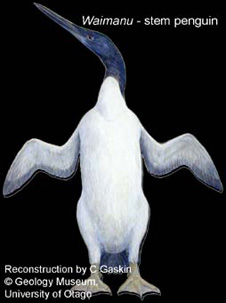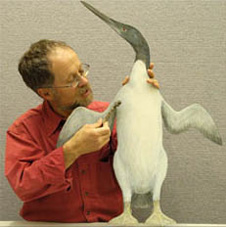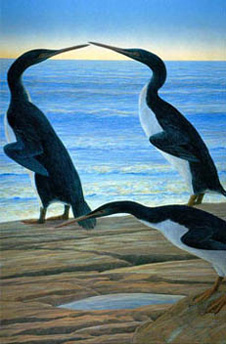 The reconstruction shown here, by Chris Gaskin, is © Geology Museum, University of Otago.
The reconstruction shown here, by Chris Gaskin, is © Geology Museum, University of Otago.
An online article recently published in the journal Molecular Biology and Evolution (March 2006) recognises a new genus of ancient penguin (Waimanu) from New Zealand rocks some 60-62 million years old. The ancient penguins lived in shallow seas off eastern New Zealand in Paleocene times, only a few million years after the extinction of dinosaurs. These "proto" penguins were about the size of living yellow-eyed penguins. They probably looked a bit like shags (cormorants), but had compressed and dense wing bones, allowing wings to be used to swim underwater. It is most unlikely that the Waimanu penguins could fly in air. These fossils are a little older than archaic penguins from Tierra del Fuego, documented by Dr Julia Clarke and coauthors (2003), and are the oldest fossil penguins reported from New Zealand.
Because the Waimanu penguins are well dated in terms of geological age, it is possible to use that known age to calibrate a new molecular phylogeny - or pattern of relationships - for living birds. The phylogeny shows a branching pattern of bird relationships based on study of genetic material from a range of living birds such as storks, albatrossses, ducks and moas. By using the dates from the fossil Waimanu penguins as a calibration point, we can then predict how far back in time the other groups of living birds originated. If early penguins lived in southern seas not long after the extinction of dinosaurs, then other bird groups more distantly related to penguins must have been established even earlier.
 Ewan Fordyce shows the position of the humerus, or upper wing bone, on a reconstruction of Waimanu tuatahi
Ewan Fordyce shows the position of the humerus, or upper wing bone, on a reconstruction of Waimanu tuatahi
The study suggests that many groups of living birds originated well back in Cretaceous times, when dinosaurs were thriving - thus, many modern lineages had ancient origins. Such a notion conflicts with an idea suggested by Professor Alan Feduccia (1995, 2003), who suggested that many living bird groups are geologically young, and mostly represent groups that arose after dinosaurs went extinct.
Feduccia argued that most birds from Cretaceous times - from the age of dinosaurs - were ancient lineages not related to living forms. He suggested that those ancient bird groups disappeared, along with dinosaurs, in a turnover at the catastrophic "KT boundary" extinction 65 million years ago. Feduccia also suggested that there was a complete new evolutionary radiation of "modern" birds following the KT extinction.
 Waimanu Reconstruction by G. Gaskin, showing 3 individuals of Waimanu tuatahi on a New Zealand beach in Paleocene times, 58-60 million years ago
Waimanu Reconstruction by G. Gaskin, showing 3 individuals of Waimanu tuatahi on a New Zealand beach in Paleocene times, 58-60 million years ago
Now, the new study which combines fossils and molecular approaches, predicts that "modern" birds thrived in the age of dinosaurs. We expect that the fossil record will continue to produce the hard evidence of those birds.
Details of title and authorship
Early Penguin Fossils, plus Mitochondrial Genomes, Calibrate Avian Evolution Kerryn E. Slack1 , Craig M. Jones2 , Tatsuro Ando3 , G. L. (Abby) Harrison4, R. Ewan Fordyce3, Ulfur Arnason5, and David Penny4
- Allan Wilson Center for Molecular Ecology and Evolution Institute of Molecular BioSciences Massey University Palmerston North New Zealand; Division of Evolutionary Molecular Systematics Department of Cell and Organism Biology University of Lund Solvegatan 29 S-223 62 Lund Sweden
- Institute of Geological and Nuclear Sciences Lower Hutt New Zealand
- Department of Geology, University of Otago Dunedin New Zealand
- Allan Wilson Center for Molecular Ecology and Evolution Institute of Molecular BioSciences Massey University Palmerston North New Zealand
- Division of Evolutionary Molecular Systematics Department of Cell and Organism Biology University of Lund Solvegatan 29 S-223 62 Lund Sweden
Read the full article – Early Penguin Fossils, plus Mitochondrial Genomes, Calibrate Avian Evolution
The first specimen of Waimanu was found in the 1980s, by Brad Field (then of NZ Geological Survey), and was passed to Ewan Fordyce for study. Craig Jones prepared the specimen - now curated in the Geology Museum of University of Otago - while working for Fordyce as a technician. Fordyce and Jones (1990) later published some details of the first fossil. Subsequently, Al Mannering (of Christchurch, affiliated with Canterbury Museum) discovered more Paleocene penguins (Jones and Mannering 1997) which Mannering prepared; those fossils are curated in Canterbury Museum, Christchurch. Most recently, the Waimanu fossils have been studied in detail by Geology graduate student Tatsuro Ando, as part of his PhD studies at University of Otago. Al Mannering's sterling efforts of collecting and preparation are honoured in the name of one of the species, Waimanu manneringi.
For details of molecular studies, contact Professor David Penny of Massey University.
References
Clarke, J. A., Olivero, E. B., and Puerta, P. 2003. Description of the earliest fossil penguin from South America and first Paleogene vertebrate locality of Tierra del Fuego, Argentina. American Museum Novitates (3423): 1-18.
Feduccia, A. 1995. Explosive evolution in Tertiary birds and mammals. Science 267 (5198): 637-8.
Feduccia, A. 2003. 'Big bang' for tertiary birds? Trends in Ecology & Evolution 18 (4): 172-176.
Fordyce, R. E. and Jones, C. M. 1990. The history of penguins, and new fossil penguin material from New Zealand. Pages 419-446 in Davis, L. S. and Darby, J. D. (editors), Penguin biology. Academic Press, San Diego. 467 p.
Jones, C. M. and Mannering, A. 1997. New Paleocene fossil bird material from the Waipara Greensand, North Canterbury, New Zealand. Geological Society of New Zealand miscellaneous publication 95a: 88.
Simpson, G. G. 1971. A review of the pre-Pliocene penguins of New Zealand. Bulletin of the American Museum of Natural History 144: 321-378.
- Introduction
- Otago History
- Reptiles
- Dolphins
- Sharks
- Whales
-
Fossil penguins
- Palaeeudyptes antarcticus
- Kairuku
- Waimanu manneringi
-
Amphibians
-
Geological settings
- Vanished World Trail
- Geology Museum
